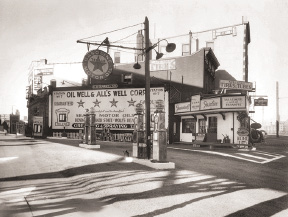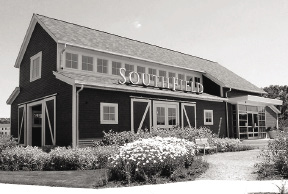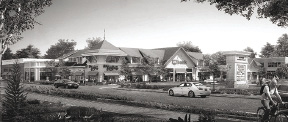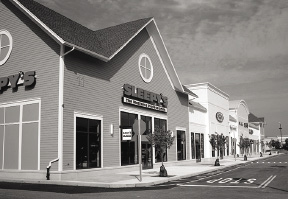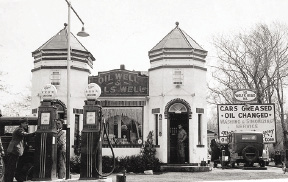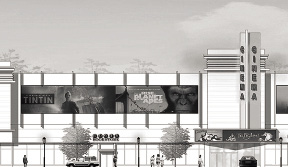I was 5 years old when my paternal grandfather died. My grandfather wasn't an architect, or a learned man; he was a Hungarian immigrant with an entrepreneurial spirit who arrived at Ellis Island at the dawn of the 20th Century. I grew up in a suburban New York home, adorned with photographs of the buildings he designed as a layperson. I didn't realize it then, but viewing those photographs during my youth would make an indelible mark on me and would inform both my own shaping of the built environment and my practice as an architect and urban designer.
By the late 1920s, Phillip Smook owned and operated the Smook Bros. Garage in Manhattan's Lower East Side. With the new suburban landscape beginning to emerge and expand eastward into Long Island, Phillip and his three young sons took their vision further and founded the Oil Well and All's Well Corporation and a chain of off-brand gas stations by the same name. The company enjoyed rapid business expansion in the 1930s that brought with it Phil's first venture into architecture and urban design. Untrained but a visionary, Phil designed dozens of service stations that foreshadowed many of today's ideas about retail branding and the use of a standard kit-of-parts aesthetic. Unique signage and bold designs were signatures of Phil's work, so much so that in 1934, he received an award for the "Best Looking Service Station" along Nassau County's most traveled highway. The company's slogan "Use a Tank Full and be Thankful" became the predominant message adorning his buildings.
With America thrust into World War II, Phillip's three sons were off to Europe to fight. Over time as gas was rationed, all stations save one were shuttered. By the late 1940s, and upon the safe return of his sons from overseas, Phil leased several properties to the Shell Oil Corp. Others were developed as retail or restaurant locations under the ownership of the SMOOK & SONS Realty Company.
Today at SMOOK Architecture & Urban Design, Inc., we have a thriving practice in Boston's Leather District that embraces a rich diversity of project types including custom homes, multifamily housing, hospitality and assisted living facilities, retail/dining/entertainment venues, and medical office buildings, as well as mixed-use master planning and urban design.
In our work we find ourselves implementing similar design elements and strategies to those my grandfather used, playing off traditional themes with contemporary interventions, and manipulating form and scale. One such example is reflected in the design of the Southfield Marketing and Sales Center for LNR, located at the site of the former South Weymouth Naval Air Station, where bold marquee signage set against a rural iconographic architectural form announces arrival at this new mixed-use community. As a member of the design review committee for Southfield, SMOOK Architecture has in turn set the tone for other buildings in that same development.
As our projects push further and further from the urban core, we have embraced Phillip's use of buildings as billboards and marquees to visually entice and engage the passing motorist and pedestrian, a concept which is reflected in our recent designs. Using a building as an armature for signage was the conceptual basis behind the Cinema building to be constructed at The Point in Littleton, Mass. at the intersection of I-495 and Rte. 119, which is being developed by Sam Park & Company. Other elements such as strategically placed towers augment and punctuate the retail experience of this trendy destination and hark back to the towers of Grandpa Phil's designs.
The use of blade signs, towers, and other iconographic architecture utilized by my grandfather are visible in our other retail work as well. Our interpretations of his ideas can be seen at a new 30,000 s/f building in Worcester along Rte. 146, developed by Madison Properties and designed by SMOOK Architecture to serve as a lifestyle retail link between a newly constructed Sam's Club and Walmart. The design challenge was to create a building of sufficient scale and iconography that it would visually stand up between these two mega-boxes and yet maintain a strong presence for smaller tenants. By designing four simple and over-scaled forms that are discretely linked yet distinct, we created a building that appears as a visual bridge between the two super-sized boxes. Our design celebrates some of the same whimsy that grandpa Phil brought to his early roadside service stations.
In Bedford along the historic Great Road, our intervention is more subtle but nonetheless iconographic, with architecture harking back to themes local to the area. This redevelopment by Salvatore Capital Partners again incorporates Phil's design ideas by punctuating and activating the corner with a new retail tower that draws vehicles and pedestrians alike into a new park-like setting running deep into the revitalized retail core.
As SMOOK Architecture's body of work grows, we pay tribute to the innovative work of this Hungarian immigrant, Phillip, and the memories of his wife Mary, and of their three sons, Arthur, Norman, and Lawrence. As the founding principal of SMOOK Architecture & Urban Design, Inc., I am honored to carry my grandfather Phillip's visionary work in the fields of urban design, architecture, and retail branding into the 21st century.
Clay Smook, AIA, LEED-AP, BD+C, is founding principal of SMOOK Architecure & Urban Design, Inc., Boston, Mass.








